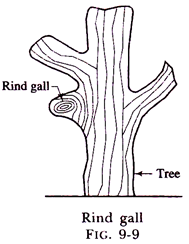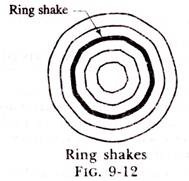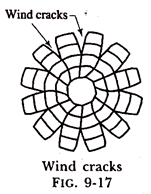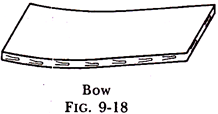The defects occurring in the timber are grouped into the following five divisions: (1) Defects due to Conversion (2) Defects due to Fungi (3) Defects due to Insects (4) Defects due to Natural Forces (5) Defects due to Seasoning.
The various types of defects under each category will now be briefly discussed.
(1) Defects due to Conversion:
During the process of converting timber to the commercial form, the following defects may occur:
(i) Chip mark
ADVERTISEMENTS:
(ii) Diagonal grain
(iii) Torn grain
(iv) Wane
(i) Chip Mark:
ADVERTISEMENTS:
This defect is indicated by the marks or signs placed by chips on the finished surface of timber. They may also be formed by the parts of a planning machine.
(ii) Diagonal Grain:
This defect is formed due to improper sawing of timber. It is indicated by diagonal mark on straight grained surface of timber.
(iii) Torn Grain:
ADVERTISEMENTS:
This defect is caused when a small depression is formed on the finished surface of timber by falling of a tool or so.
(iv) Wane:
This defect is denoted by the presence of original rounded surface on the manufactured piece of timber.
(2) Defects due to Fungi:
The fungi are minute microscopic plant organisms.
ADVERTISEMENTS:
They attack timber only when the following two conditions are satisfied simultaneously:
(i) The moisture content of timber is above 20 per cent.
(ii) There is presence of air and warmth for the growth of fungi.
If any of these conditions is absent, the decay of wood due to fungi would not occur. Hence the dry wood having moisture content less than 20% will remain sound for centuries. Similarly the wood submerged in water will not be attacked by fungi because of absence of air.
ADVERTISEMENTS:
Following defects are caused in the timber by the fungi:
(i) Blue stain
(ii) Brown rot
(iii) Dry rot
(iv) Heart rot
(v) Sap strain
(vi) Wet rot
(vii) White rot
(i) Blue Stain:
The sap of wood is stained to bluish colour by the action of certain type of fungi.
(ii) Brown Rot:
The term rot is used to indicate decay or disease of timber. The fungi of certain types remove cellulose compounds from wood and hence the wood assumes the brown colour. This is known as the brown rot.
(iii) Dry Rot:
The fungi of certain types feed on wood and during feeding, they attack on wood and convert it into dry powder form. This is known as the dry rot.
Following facts in connection with the dry rot are to be noted:
(a) The dry rot occurs at places where there is no free circulation of air such as improperly ventilated basements, rooms, etc. and in damp situations like kitchen, toilets, etc.
(b) The unseasoned soft woods and sap wood are easily attacked by dry rot.
(c) If timber is not properly stored after being felled down, it is liable for the attack of dry rot.
(d) The most favourable conditions for the rapid growth of fungus responsible for dry rot are absence of sunlight, dampness, presence of sap, stagnant air and warmth.
(e) The dry rot is also caused by charring, painting and tarring the unseasoned timber.
(f) The dry rot may be prevented by using well-seasoned timber free from sap.
(g) When part of timber is seriously affected by dry rot, the damaged portion may be completely removed and the remaining unaffected portion should be painted with a solution of copper sulphate.
(iv) Heart Rot:
This is formed when a branch has come out of a tree. In such a case, the heart wood is exposed to the attack of atmospheric agents. Ultimately the tree becomes weak and it gives out hollow sound when struck with a hammer.
(v) Sap Stain:
The fungi of certain types do not bring about the complete decay of timber. But they feed on cell contents of sap wood. In doing so, the sap wood loses its colour. This is known as the sap stain and it generally occurs when moisture content goes beyond 25 per cent or so.
(vi) Wet Rot:
Some varieties of fungi cause chemical decomposition of wood of the timber and in doing so, they convert timber into a greyish brown powder. This is known as the wet rot.
The important facts to be remembered in connection with the wet rot are as the follows:
(a) The alternate dry and wet conditions favour the development of wet rot.
(b) If unseasoned or improperly seasoned timbers are exposed to rain and wind, they become easily liable for the attack of wet rot.
(c) To prevent wet rot, the well-seasoned timber should be used for exterior work or for underground work and it should be covered by tar or paint for protection against moisture.
(vii) White Rot:
This defect is just the opposite of brown rot. In this case, certain types of fungi attack lignin of wood and the wood assumes the appearance of a white mass consisting of cellulose compounds.
(3) Defects due to Insects:
Following are the insects which are usually responsible for the decay of timber:
(i) Beetles
(ii) Marine borers
(iii) Termites.
(i) Beetles:
These are small insects and they cause rapid decay of timber. They form pin-holes of size about 2 mm diameter in wood. They attack the sap wood of all species of hard woods. The tunnels are formed in all directions in sap wood by the larvae of these beetles. The timber is converted into fine flour-like powder. They usually do not disturb the outer shell or cover. Hence, the timber piece attacked by beetles may look sound till it completely fails.
(ii) Marine Borers:
These are generally found in the salty water. The most of the varieties of marine borers do not feed on wood. But they make holes or bore tunnels in wood for taking shelter. The diameter and length of these holes may go as high as 25 mm and 60 mm respectively. The wood attacked by marine borers loses colour and strength. It may be noted that no timber is completely immune from the attack of marine borers.
(iii) Termites:
These are popularly known as the white ants and they are found in abundance in tropical and sub-tropical countries. These insects live in a colony and they are very fast in eating away the wood from core of the cross-section. They make tunnels inside the timber in different directions and usually do not disturb the outer shell or cover.
Hence, the timber piece attacked by termites may look sound till it completely fails. Very few good timbers such as teak, sal, etc. can resist the attack of white ants. Such timbers have certain chemicals in their composition and the smell of these chemicals is not favourable for the termites.
(4) Defects due to Natural Forces:
The main natural forces responsible for causing defects in timber are two, namely, abnormal growth and rupture of tissues. Following defects are caused by these forces:
(i) Burls
(ii) Callus
(iii) Chemical stain
(iv) Coarse grain
(v) Dead wood
(vi) Druxiness
(vii) Foxiness
(viii) Knots
(ix) Rind galls
(x) Shakes
(xi) Twisted fibres
(xii) Upsets
(xiii) Water stain
(xiv) Wind cracks.
(i) Burls:
These are also known as the excrescences and they are particularly formed when a tree has received shock or injury in its young age. Due to such injury, the growth of tree is completely upset and irregular projections appear on the body of timber.
(ii) Callus:
It indicates soft tissue or skin which covers the wound of a tree.
(iii) Chemical Stain:
The wood is sometimes discoloured by the chemical action caused with it by some external agency. This is known as the chemical stain.
(iv) Coarse Grain:
If a tree grows rapidly, the annual rings are widened. It is known as the coarse grained timber and such timber possesses less strength.
(v) Dead Wood:
The timber which is obtained from dead standing trees contains dead wood. It is indicated by light weight and reddish colour.
(vi) Druxiness:
This defect is indicated by white decayed spots which are concealed by healthy wood. They are probably formed for the access of fungi.
(vii) Foxiness:
This defect is indicated by red or yellow tinge in wood or reddish brown stains or spots round the pith of tree discolouring the timber. It is caused either due to poor ventilation during storage or by commencement of decay due to over-maturity or due to growth of tree in a marshy soil.
(viii) Knots:
These are the bases of branches or limbs which are broken or cut off from the tree. The portion from which the branch is removed receives nourishment from the stem for a pretty long time and it ultimately results in the formation of dark hard rings which are known as the knots. As continuity of wood fibres is broken by knots, they form a source of weakness. Fig. 9-8 shows a typical knot.
(ix) Rind Galls:
The rind means bark and gall indicates abnormal growth. Hence peculiar curved swellings found on the body of a tree are known as the rind galls as shown in fig. 9-9. They develop at points from where branches are improperly cut off or removed. They are rarely found in a tree and the timber in this part is very weak and not durable.
The knots are classified on the basis of their size and form. Table 9-5 shows the classification of knots on the basis of their size.
Table 9-6 shows the classification of knots on the basis of their form and quality.
(x) Shakes:
These are cracks which partly or completely separate the fibres of wood.
(a) Cup Shakes:
These are caused by the rupture of tissue in a circular direction as shown in fig. 9-10. It is a curved crack and it separates partly one annual ring from the other. It develops due to non-uniform growth or due to excessive bending of a growing tree during a cyclonic weather. It may not prove to be harmful, if it covers only a portion of ring.
(b) Heart Shakes:
These cracks occur in the centre of cross-section of tree and they extend from pith to sap wood in the direction of medullary rays as shown in fig. 9-11. These cracks occur due to shrinkage of interior part of tree which is approaching maturity. The heart shakes divide the tree cross-section into two to four parts.
(c) Ring Shakes:
When cup shakes cover the entire ring, they are known as the ring shakes as shown in fig. 9-12.
(d) Star Shakes:
These are cracks which extend from bark towards the sap wood. They are usually confined upto the plane of sap wood.
They are wider on the outside ends and narrower on the inside ends. They are usually formed due to extreme heat or severe frost during the growth of the tree. Fig. 9-13 shows the star shakes.
(e) Radial Shakes:
These are similar to star shakes. But they are fine, irregular and numerous. They usually occur when tree is exposed to sun for seasoning after being felled down. They run for a short distance from bark towards the centre, then follow direction of annual ring and ultimately run towards pith. Fig. 9-14 shows the radial shakes.
(xi) Twisted Fibres:
These are also known as the wandering hearts and they are caused by twisting of young trees by fast blowing wind. The fibres of wood are twisted in one direction as shown in fig. 9-15. The timber with twisted fibres is unsuitable for sawing. It can however be used for posts and poles in an un-sawn condition.
(xii) Upsets:
These are also known as the ruptures and they indicate the wood fibres which are injured by crushing or compression. Fig. 9-16 shows a timber piece with this defect. The upsets are mainly due to improper felling of tree and exposure of tree in its young age to fast blowing wind.
(xiii) Water Stain:
The wood is sometimes discoloured when it comes into contact with water. This is known as the water stain and this defect is usually found in converted timber.
(xiv) Wind Cracks:
If wood is exposed to atmospheric agencies, its exterior surface shrinks. Such a shrinkage results into cracks as shown in fig. 9-17. These are known as the wind cracks.
(5) Defects due to Seasoning:
Following defects occur in the seasoning process of wood:
(i) Bow
(ii) Case-hardening
(iii) Check
(iv) Collapse
(v) Cup
(vi) Honey-combing
(vii) Radial shakes
(viii) Split
(ix) Twist
(x) Warp.
(i) Bow:
This defect is indicated by the curvature formed in the direction of length of timber as shown in fig. 9-18.
(ii) Case-Hardening:
The exposed surface of timber dries very rapidly. It therefore shrinks and is under compression. The interior surface which has not completely dried is under tension. This defect is known as the case-hardening and it usually occurs in timbers which are placed at the bottom during seasoning.
(iii) Check:
A check is a crack which separates fibres of wood. It does not extend from one end to the other.
(iv) Collapse:
Due to uneven shrinkage, the wood sometimes flattens during drying. This is known as the collapse.
(v) Cup:
This defect is indicated by the curvature formed in the transverse direction of timber as shown in fig. 9-19.
(vi) Honey-Combing:
Due to stresses developed during drying, the various radial and circular cracks develop in the interior portion of timber. The timber thus assumes the honey-comb texture and the defect so developed is known as the honey-combing.
(vii) Radial Shakes:
These are radial cracks. They are explained earlier and are shown in fig. 9-14.
(viii) Split:
When a check extends from one end to the other, it is known as a split.
(ix) Twist:
When a piece of timber has spirally distorted along its length, it is known as a twist. It is shown in fig. 9-20.
(x) Warp:
When a piece of timber has twisted out of shape, it is said to have warped.














